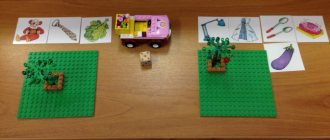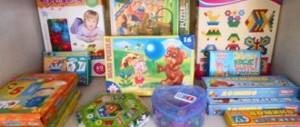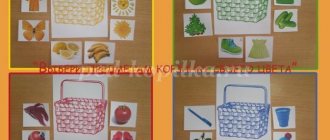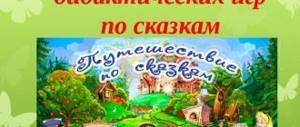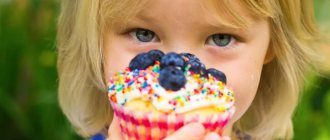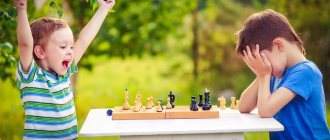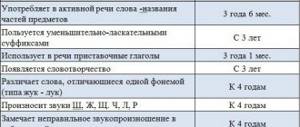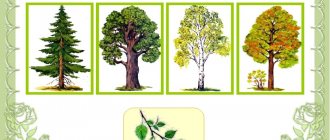Summary of a lesson on fire safety in the middle group. Topic: “Fire – our friend or enemy? »
Summary of a lesson on fire safety in the middle group.
Topic: “Fire – our friend or enemy? »
Purpose: 1. Educational: - to give children an understanding of the benefits and dangers of fire; — introduce children, in an entertaining way, to basic fire safety rules; - give children the necessary knowledge on how to behave if a fire starts; 2. Developmental: - develop coherent speech; - enrich the vocabulary; develop memory, intelligence, thinking; 3. Educational: - cultivate the ability to listen; - cultivate a caring attitude towards your life; Educational field. Safety: — formation of ideas about fire safety rules; Music: - introduction to the art of music; Communication: - development of free communication with adults; Cognition: - formation of a holistic picture of the world, broadening the horizons of children; Type of lesson: integration Equipment: Computer, multimedia presentation for the lesson. Progress of the lesson Educator: Today guys we will learn a lot of interesting things. And what exactly, you tell me yourself by solving the riddle! The red animal sits in the oven, The red animal looks at everyone, He eats firewood out of anger, Maybe an hour, maybe two, Don’t touch him with your hand, He bites your palm. What is this? That's right, fire. Educator: That’s what our conversation will be about. Where do you think the fire first came from? A story about fire. The first fire appeared several thousand years BC. The first people, like animals, were very afraid of fire. They trembled in horror when the tree caught fire from a lightning strike. But one day the bravest of them came closer to the fire. Light and warmth came from the fire. People thought about how to keep the fire going. Ancient man began to constantly throw dry branches and grass into the fire. The result was a fire that could burn for a long time. Then the man began to preserve the smoldering coals. People learned to make fires in caves, which served as their homes. The fire's flame helped them survive during cold weather and cook food. This is how the first people began to use fire. Guys, we received a letter this morning. On the envelope it is written: “For the children of kindergarten No. 12 from Khryusha and Stepashka.” Listen to what they write. "Hello children! I am in hospital. I want to tell you how I got here. I visited Stepashka, we read books, drew, sculpted from plasticine, and then it became boring and we decided to come up with a new game. And they found matches and began to play with them. At first we had fun, it was interesting. We really liked how the match struck the box, how the fire flared up, and then the fire crept up to our paws, we were afraid of getting burned and threw the match on the floor. And then I don’t remember anything, I only woke up in the hospital with Stepashka. Now we feel very bad, our paws and ears hurt. Doctors are treating us. Guys, don't trust matches, they can cause a lot of trouble. They are cunning and always ask for children’s hands.” Educator. Guys, why did Khryusha and Stepashka end up in the hospital? Children's answers. Educator. Is it possible to play with matches? What could such a game lead to? Educator. Right. The harm of fire depends on the person. Adults know how not to quarrel with fire, and children need to learn this too. Educator. Think about when fire can be kind and useful for a person? Children's answers. Educator: Fire is a long-time friend of man. It provides a person with warmth and light. With its help, many useful things are accomplished. The power of fire is very great. Fire warms, makes cars work, launches rockets and spaceships. Food is cooked on fire. It is needed in homes, kindergartens, schools, farms, factories, hospitals. People bow their heads before the eternal flame at the monuments to heroes. And the Olympic flame is lit from the rays of the sun. All this is good fire. And now I will read a poem to you, and you listen to it carefully. For those who are not careful with fire, a fire is possible. Remember everything: You can’t joke with fire. Guys, what do you think this poem tells us? Children's answers. You can't joke with fire. Since a fire can occur in which things, a house, a forest can burn, and people and animals can also die. Now let's take a little rest. Let's get back on our feet. Physical exercise We stomp our feet: stomp-stomp-stomp, And we clap our hands: clap-clap-clap. Toe-heel, toe-heel, And now let's go into a squat. Let's squat. We squat and like birds we fly. They stretched on their tiptoes and bent over the mushrooms. Now hurry up and run, no one can catch us. Educator: Guys, look carefully at the picture. Who is this? Children: Firefighter. Educator: How did you guess? Children: He is wearing a helmet, in a special suit, and has a water hose in his hands. Educator: The fireman is dressed in a canvas suit; it does not get wet and does not burn in a fire. Why do you think a fireman needs a helmet? Children's answers. Educator: The helmet protects the head from blows if something falls on the firefighter. When a fire occurs, it is very dangerous. Therefore, it is necessary to comply with all fire safety rules. After all, putting out a fire is not easy. What do you think a firefighter should be like? Children's answers. Educator: Bold, courageous, strong, smart, quick-witted. What kind of people won’t be hired as firefighters? Children's answers. Educator: Lazy, cowardly, weak. Educator: Would you like to become young firefighters? Children: Yes Educator: For this you need to know and be able to do a lot. We will conduct tests today, and if you succeed, you will be given young firefighter medals. So, let's begin! Educator: What do you think could cause a fire? • Incorrect handling of fire – matches, fire • Do not leave switched on electrical appliances unattended! • Careless handling of pyrotechnic products (crackers, firecrackers, sparklers, fireworks, etc. Educator: What should you do if there is a fire in your home? Children's answers. Educator: • You need to call the firefighters by phone 01 or cell phone 112 • You can’t hide from fire and smoke, you need to leave the room urgently. • In a smoky room you need to breathe through a wet cloth. Educator: Guys, you said that if there is a fire, you need to call the firefighters by phone. But what do you need to tell the firefighters by phone? Children: Address, last name, what is burning. Educator: And now we will play a game called “Make no mistake.” I will name the words, and when you hear the word related to the fire, you should clap your hands and stamp your feet. Prepared: fireman, cake, saw, fire extinguisher, flowers, brush, helmet, fire, notes, matches, 01, smoke, bear, fire truck. Educator: Well done, you completed the task. And now, so that we can remember everything well again, the guys will read poems for us. 1st child: The match is not big in height, Don’t look at how small it is. This little match can do a lot of evil. Child 2: If you turned on the iron, you don’t need to run away suddenly. When closing the door in the house, Check if everything is turned off, check 3 child: If the telephone is close and you can access it, You need to dial 01 And quickly call the firefighters. 4 child: If there is a big fire, everything is engulfed in smoke. Run out of the house. Everyone, guys, should. And quickly call for help, call people. 5th child: Firefighting is for strong guys. Firefighting is about saving people. Firefighting is courage and honor. Firefighting – that’s how it was, that’s how it is. Smart guys. Now let's send a response letter to Khryusha and Stepashka, but before we send it, we need to select pictures on the board with safety rules that must be followed to prevent a fire. Well done guys, now Khryusha and Stepasha will know what safety rules need to be followed to prevent a fire from happening. Guys, you did an excellent job with all the tasks, and now it’s time to present you with medals for young firefighters (The “Firemen’s March” sounds - the teacher presents the medals).
Card index of conversations in the middle group
Usually thematic blocks are included in the outline:
- Day of Knowledge;
- autumn;
- well-being;
- professions;
- safety;
- health;
- kindness;
Dialogue in preschool educational institutions
- family;
- my city;
- transport;
- famous people;
- culture;
- emotions;
- New Year;
- nature;
- boys and girls;
- defenders of the fatherland, military specialties;
New Year theme
- design;
- Easter;
- guests;
- Mother;
- space;
- folk art;
- spring, winter;
- Victory Day;
- Emotional behavior;
- sport;
- morning;
- Street;
- summer.
Note! All these topics are related to the events that children experience and the environment in which they grow up.
Conversation with children of the middle group: life safety
The main goal of the dialogue on life safety is to explain to children the fact that even simple things can be fraught with danger and must be handled with care. When talking with children, you should pay attention to dangerous objects surrounding children at home. Among these dangers are:
- The presence of piercing and cutting objects in large quantities in everyday life (scissors, needles, pins, etc.). The emphasis should be on the fact that all these things must be stored in the proper place.
- Availability of household chemicals. It is important to convey to children that although powders, insect repellents, dishwashing detergents and other household chemicals may often be attractively packaged, they should not be eaten.
- Medications. The goal is to explain to children that they need to take pills only when there is a medical indication. In everyday life, the use of medications (even beautiful tablets and tasty syrups) can adversely affect your health.
- Electrical appliances. Common household appliances may cause fire or electric shock.
During this conversation, we can mention flammable Christmas tree decorations and garlands.
Also, during the conversation on life safety, the importance of such special services as ambulance, police and firefighters should be touched upon. It is necessary to clearly explain the purpose of each of them:
- ambulance - a doctor is required;
- firefighters - the fire is raging;
- police - we need to protect life in a dangerous situation and ensure law and order.
Note! Fires need to be addressed as a separate topic in this series. Children need to be told about the causes of fires and the actions that need to be taken in an emergency. Explain that you cannot play with fire, and this can lead to very sad consequences.
Conversation about mother in the middle group
Mom is the most important person in a child’s life. In childhood, you need to develop a sense of respect for women, love for your family and friends. It is advisable to organize such a dialogue on holidays such as Mother’s Day or International Women’s Day.
During such conversations, children should be given a lot of interaction:
- tell poems about mommy;
- call mothers with kind and gentle words;
- offer options for helping mom.
Talk about mom
All this can be combined with numbers and skits that children rehearse for their mothers and then show them. This will help children learn to demonstrate their feelings and receive maternal warmth and care.
Conversation about professions in the middle group
During such a conversation, the main goal is to form and consolidate children’s ideas about various professions. Particular attention should be paid to such professions as:
- teachers;
- doctors;
- engineers;
- sellers and others.
Drawing lesson on the topic “Who do you want to be” in preparatory groups
This conversation is most effective in the format of an interactive journey through the stations. At each station, children get to know the specifics of one profession in a playful way. During their stay at the station, the children try to guess what kind of profession the teacher is presenting to them. Then they talk about what the profession does.
Note! You can organize a small master class, during which children will immerse themselves in the atmosphere of the profession.
A particularly important element is the discussion of professions in the middle group. At this stage, the student already understands what adults do. He shows interest in their activities. Through the study of professions, the child forms his ideas about the world, learns to respect and appreciate the work of other people. In addition, this is the first stage of vocational guidance, at which the child shows individual inclinations and interests.
Conversations about health in the middle group
The purpose of the conversation should be to develop children’s initial skills about protecting life and health. Children must learn to draw conclusions about the safety of a particular action.
It is necessary to develop in them a sense of mutual assistance and mutual assistance. During the conversation, it is worth determining exactly how children understand the very concept of “health” and conveying that health is human wealth. It is important to discuss with children those situations in which they can harm their health.
Note! In a conversation about health, it is worth including a minute of physical education and a discussion of nutrition culture. After all, the formation of a healthy body depends on a balanced diet.c
Another important aspect to consider during the discussions in this unit is personal hygiene. An excellent tool for this is the work “Moidodyr”.
Transport topics
Topic "Transport" in the middle group
A conversation on this topic is intended to help systematize children’s ideas regarding the methods and characteristics of people’s movement.
You need to talk to your children about several main aspects of this topic:
- highlight the purposes for which transport is used;
- present a classification of modes of transport.
Pictures, videos, presentations and toys can be used as supporting material.
Note! Demonstration material must be clearly prepared.
Conversation about pets in the middle group
The main goals of conducting such a conversation from a cognitive point of view:
- deepen children's knowledge about pets;
- to form the concept of “pets” in the minds of the younger generation;
- to cultivate love and the ability to care for our smaller brothers.
This lesson involves examining illustrative material, discussing the basic habits of pets, their benefits and purpose, as well as the rules for handling pets. Children can be told interesting facts about each pet to capture their attention and begin to develop an interest in biology.
Conversations on healthy lifestyle in the middle group
This series of conversations is closely intertwined with conversations about health. During them, children are taught the basics of biology - the human body is studied, children get acquainted with the main functions and organs of a person, and try to understand why each of them is needed. Also, in a playful form, material is presented about those factors that have a detrimental effect on human health.
The purpose of the classes is to develop in the student the value of a healthy lifestyle, nutritional culture, and sports.
Family theme
Conversations about family in the middle group
Children should receive a formed idea of what a family is and how valuable it is in everyone’s life.
Spiritual and moral education of a preschooler through fairy tales
It is important to convey to the little ones that families are different, large and small. At the same time, it is the family that is the support in every person’s life.
During these conversations, as an interactive activity, you can invite children to look at photographs and write short stories about their families. Such an activity will favor the development of the speech apparatus and the ability to express thoughts coherently.
Note! You can supplement the lesson by reading and learning short works about family and relatives. This will also have a beneficial effect on the development of children's memory.
Conversations about safety in the middle group
They need to be done with children regularly.
During such conversations, you need to touch on several blocks of topics:
- weather conditions (ice, rain, extreme cold or heat);
- traffic rules (traffic rules);
- plants, mushrooms and animals (insects, dogs, poisonous mushrooms, etc.).
Such conversations are best conducted in the format of situational discussion. This will help immerse children in the real world and help them orient themselves in the future. Children will analyze a specific situation, which will develop critical thinking. You can supplement the conversation with demonstration material, coloring/drawing, as well as poems and sayings.
Children's conversations about autumn in the middle group
A conversation about autumn will teach children to see the connection between the length of daylight hours, climate indicators, as well as the behavior of animals and plants. Such a conversation will contribute to the formation of a caring attitude towards flora and fauna. Will teach you to distinguish the autumn months from the spring (March, April, May) and winter (December, January and February).
This is one of the most favorable conversation topics for introducing a student to literature. There are a huge number of easy-to-understand poems that children can learn by heart. Also, using autumn pictures, you can teach children to compose their own texts, which has a beneficial effect on children’s speech culture.
